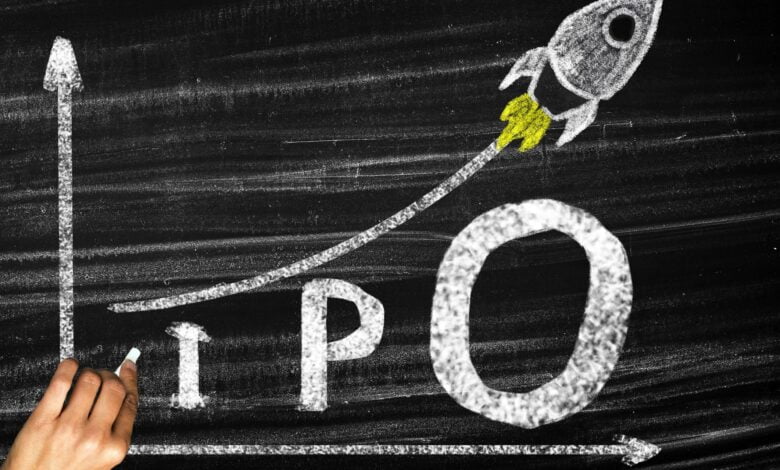What is an initial public offering (IPO)? What They Are and How They Work

What is an initial public offering (IPO)? What They Are and How They Work
An IPO (Initial Public Offering) means investing in a company before publicly trading. IPOs allow you to invest in the growth stories of your favorite firms before they hit the market, from software giants to fast-food chains.
When we wish to establish a new business, we either put our own money into it or borrow it from friends and family. We demand more and more finances as the company grows, and we either take out bank loans or contact other corporations, investors, and venture capitalists to obtain them.
Even after all this, when our funds run out, and we need more money to build our firm, we eventually turn to the general public for help.
Before we go any further, let’s define what an IPO (Initial Public Offering) is.
What is the definition of an Initial Public Offering (IPO)?
An initial public offering (IPO) is when a privately owned company sells shares to outside investors on a stock exchange for the first time. Investors can buy and sell such shares whenever they want, and the corporation no longer controls who owns stock.
Why do businesses choose to go public? Because it lets, investors (for example, venture capitalists and long-serving employees) receive a return on their investment and because it’s a powerful technique to generate money rapidly. The money is used to fund research and development, pay off debt, and launch new items. Traders like you get a piece of the company in exchange for funding, and you can sell those shares when the company’s value rises (hopefully).
An IPO also signifies a significant shift in the company’s operations. Because it is no longer a private company, it is required to publish quarterly and annual financial reports so that traders may understand what they are purchasing. Shareholders must also have a say in some issues, such as who sits on the board of directors.
While initial public offerings (IPOs) are appealing opportunities to purchase shares of hot firms, keep in mind that many trendy IPOs lose value on their first day of trading. For example, Facebook lost weight almost immediately after its IPO and took more than a year to trade above its IPO price.
What does this imply for investors?
When you purchase a stock in an initial public offering (IPO), you become a stakeholder in the firm. It means you become the owner of the portion of the company for which you paid for the share.
Let’s have a look at some interesting aspects of initial public offerings.
You may have heard on various media channels that investing in so and so IPOs will make you lakhs in a day due to the listing gain. Is this, however, correct? In a nutshell, the answer is no.
You can’t invest an endless amount of money in an IPO, for starters. For instance, if you want to acquire an ITC share, you can do so for Rs 1000 or Rs 10,000, depending on your preference. You can’t do it in an IPO, though. Unlike stocks, IPOs can only be purchased in bulk. So you may either take one lot or numerous lots, which generally amount to roughly Rs 14,000 or Rs 15,000 in total.
So, even if you receive the listing gains and double your money, you’ll only get roughly Rs 15,000 in profit. As a result, it’s a myth that you can invest in an IPO and get wealthy overnight.
Second, successful initial public offerings (IPOs) are oversubscribed. Take, for example, IRCTC, which has been oversubscribed 112 times! But what exactly does that imply? It indicates that out of 112 applicants, only one was chosen for the IPO. And getting this IPO among 112 people for Rs 15,000 requires a lot of luck.
The question now is:
Should you invest in an initial public offering (IPO)?

Let’s look at an example once more to help you comprehend. You want to invest in an ITC stock and wish to pay Rs 200 for it. There is now another investor who owns ITC shares and wants to sell them for Rs 210. In this scenario, a seller and a buyer meet and agree to sell and buy the share for Rs 200, resulting in the trade being completed.
The price of shares is negotiable when we trade them. However, in the case of initial public offerings, this is not the case. The pricing is set in stone and cannot be changed.
Let’s take a look at who determines the IPO prices.
After all, they aren’t decided by the government or the general population.
The company’s owners determine this pricing.
Let’s look at another case. Assume there is a landowner who wishes to sell her property. What would she want now? She’d like to earn the most money for her property, not the least. She will not assume that she will only sell within that price because the land is worth Rs Fifty Lakhs. If a buyer is willing to pay Rs Sixty Lakhs for it, she will gladly trade it for that price.
Similarly, a business owner will aim to raise as much money as possible from the general population. As a result, many initial public offerings (IPOs) are overvalued and unavailable at a reasonable price.
During the IPO, the shares, which usually cost roughly Rs 500, would be available for Rs 700 or 800.
However, not every IPO is overvalued.
Let’s take the landowner as an example. If the landowner requires money immediately, she will not wait to receive Rs Fifty Lakhs or more; she may even sell it for a lower price.
The circumstances for initial public offerings (IPOs) may be comparable. When working with banks, NBFCs, or listing their stocks on the NSE or BSE, business owners will face some limitations and experiences.
Because these firms must adhere to government, RBI, or SEBI requirements, they are under pressure to get their IPOs listed as soon as possible or face penalties if they do not do so within the required time frame. They must also be wholly subscribed. And it’s for this reason, that these IPOs aren’t overvalued: they don’t want to risk being undersubscribed.
These IPOs are referred to as Forced IPOs because they must adhere to particular RBI or SEBI criteria and sell their shares at a reasonable price. Forced IPOs are reasonably priced; thus, investing in them is good. Because of this pressure, several companies choose to list on the OFS.
How Does an Initial Public Offering Work?
Acme Inc. is considering going public. They initially choose an investment bank to guide them through the initial public offering (IPO) procedure. Applicant banks submit bids outlining the amount of money they’ll raise and the fees they’ll charge (typically three to seven per cent of the IPO’s total sales price). This process begins six to a year before the IPO date.
Acme ultimately chooses to work with Globex Bank. Globex’s costs aren’t the cheapest, but they have a reputation for generating the most money and diversifying risk by selling to many customers (rather than a few big buyers).
Globex begins the underwriting procedure. The amount of money to be raised, the sort of securities Acme will issue, and related costs are all detailed in this procedure. The success of the IPO is ensured through underwriting. This is comparable to how your mortgage bank underwrites your loan to ensure that you and the bank get a decent deal.
Globex will examine Acme’s financials over the next few months. They search for ways to sell or write off underperforming assets to maximise the company’s value. They occasionally recruit new executives or directors with prior expertise running public corporations.
Globex then files for an initial public offering (IPO) with the Securities and Exchange Commission. (Acme would file with the Financial Services Authority if it were based in the United Kingdom.) They would file with their provincial securities regulators if they were Canadian.) This “S1” filing contains financial statements, details on who owned stock before the IPO, and information on Acme’s management, legal difficulties, competition, business model, and operations.
Acme and Globex put on a “roadshow” to showcase the IPO to various interested parties across the country and possibly around the world once the security regulators authorise the offering and establish a date for the IPO. They present prospective purchasers with the company’s financial data and asking price. Investors place bids for the number of shares they want.
Acme also draughts more vendor contracts, completes more financial documents for regulators, and enters the stock exchange.
While investor discussions are private, firms like Acme rarely keep their IPO ambitions hidden. It’s not like large corporations sprout out of nowhere on the stock exchange. It’s frequently in their best interests to inflate the IPO price by creating as much hype and drama as possible.
On the day of the IPO, investors place their orders so that they will be executed when the exchange opens. The amount they pay is determined by various factors, including the company’s valuation and market conditions.
Following the IPO, there is a period of stabilisation. Acme does not want its shares to go below its IPO price, which would be embarrassing. To avoid this, Acme granted Globex an overallotment option, which allows the company to sell or short up to 15% more shares than anticipated. Globex can purchase back certain shares at a lower price if demand appears to be weak. The idea is to minimise supply and hence increase demand.
Globex files earnings predictions for Acme around a month after the IPO. IPO investors are permitted to exchange their shares six months after the IPO.
A corporation will put in a lot of effort to acquire approval to file an IPO. Filing for an IPO is similar to that of beginning a new firm. It’s not going to be easy. A regulatory authority issues an IPO approval. The Securities and Exchange Board of India in India (SEBI).
Before an IPO can be allowed, it must pass a thorough examination by the regulatory authority to establish whether it is eligible to file an IPO. The following are some of the steps involved:
- Filing an application with SEBI with all essential information, such as the number of shares to be issued, the price determined (in the case of a fixed-price IPO), the company’s historical records, and the money’s intended purpose.
- Following SEBI permission, the business produces a red herring prospectus, which comprises information about the company’s past performance and data regarding the IPO.
- The company hires a lead manager to oversee the IPO sale, which could be an investment bank or a brokerage firm.
- In some situations, the lead manager then solicits IPO bids from investors, usually financial institutions and ordinary investors.
- Investors can subscribe to the IPO when it goes online and designate the amount they want to invest. The shares are credited to the bidder’s account if they are successful.
The IPO will be offered for 3-21 days, during which interested parties can submit offers for shares. Shares may be allotted at a preset price or through the building book system, in which the price is set aftermarket demand is assessed. An IPO’s fixed cost is established by the number of bids received at various price points.
When Can a Company File for an Initial Public Offering (IPO)?
:max_bytes(150000):strip_icc()/GettyImages-1045262938-d6e77886128f4b05b3b4b4e3daef781a.jpg)
There is no one-size-fits-all metric when a company can file for an IPO. Some businesses have been around for decades before filing for bankruptcy. Others will file as soon as possible.
So, when does a company register for an initial public offering (IPO)? When it reaches a size where angel investors, venture capitalists, and private investors can no longer fund it. Offering stock to the general public provides them with a cash infusion that allows them to expand even further.
However, getting to this stage takes time. To attract investors and meet the requirements of securities authorities, the company must build a strong market position. Regulators want companies to go public to boost investment, but they don’t want companies that are volatile and cause individuals to lose money.
Prior investors (from when the firm was private) can also be compensated through IPOs. They will be able to sell their shares on the open market after the company becomes public. Those shares are probably worth more than they paid for them. As a result, early investors may exert tremendous pressure on the company to go public as soon as possible.
Here are a few other indicators that a private company is ready to go public:
- The IPO procedure is within the company’s budget. Before the company may receive investment from public investors, it must cover several expenses.
- The company’s revenue is predictable. Companies that miss their earnings or can’t foresee what those earnings will be are disliked by the market.
- The company has room for expansion. After all, everyone wants their money to increase in value.
- The company has a solid management team that has run public corporations before. Investors place a premium on leadership quality.
- The business is debt-free. People will not pay a high price for a heavily in debt company.
- The business is a big player in its field. Investors will evaluate the company in comparison to its competitors.
- Investors will know what to expect because the company has a clear five-year business plan (including financials).
What occurs after the initial public offering (IPO)?
The corporation is listed as a publicly-traded stock in a stock market once the shares are distributed to the buyers. The stakes are traded daily in compliance with the norms and regulations of the stock exchange. Depending on market demand, the claim may be changed at a price more excellent or lower than the IPO price. Some retail or institutional investors may sell equities purchased from the IPO on the first day of trade. Due to the surplus supply, the stock price may fall.
The term “float” refers to the amount of stock in circulation. After becoming a publicly traded firm, the company must make financial disclosures, audit its accounts, and release all relevant information required by the SEBI.
How to Purchase an Initial Public Offering (IPO) Stock
With most equities, you have to place an order with your broker and wait for your shares to arrive. On the other hand, IPO stock is pre-sold to a select group of investors. Before the IPO bell rings, orders have already been filed. This means that most people without special access will be unable to purchase IPO stock. There are only four ways to get your hands on shares of the company that just filed for an initial public offering.
- Collaborate with an online brokerage firm that accepts shares.
Some online brokerages are given shares to sell to their members by an investment bank. However, just though your brokerage owns shares does not guarantee that it will sell them to you. It may sell those shares to its most valuable customers. If you’re interested in a particular IPO stock, contact your brokerage.
2. Collaborate with a financial institution
Develop a relationship with an investment bank if you’re frequently interested in IPO stocks. The majority of the stock they buy will be sold to their consumers.
You don’t have to work with the underwriting investment bank directly. The IPO will benefit all of the major players. However, compared to an online robot advisor like Wealthsimple, you’ll pay more outstanding fees and commissions on your investments.
3. Look for a mutual fund that has IPO shares.
IPO stock is sold to some mutual funds. You’re still invested in the company if you buy shares in the fund, even though it officially owns the IPO stock. The catch is that you’ll also be invested in the fund’s other assets.
4. Wait and buy IPO stocks like any other stock.
You don’t have to buy a stock the moment it becomes available. It’s generally better to wait until a stock’s buzz has died down and the supply has stabilised before investing. Uber’s stock dropped 7% on its first day of trading after going public. If you had purchased IPO shares, you would have immediately lost money. Allow time for the stock to normalise to ensure you aren’t overpaying.
If all of this chatter about IPOs has piqued your interest, now is a beautiful moment to join an account. We provide cutting-edge technology, cheap costs, and the kind of individualised, pleasant service you wouldn’t expect from an automated investment firm. In just a few minutes, you can begin investing.
Why should you invest just online?
- The investor can bid online without having to deal with any hassles. The bidding process is straightforward and takes only a few minutes.
- Shares and refunds are automatically placed in your account and credited to your bank account.
- If you have an account, you can see all your stock holdings in one spot.
- You can purchase and sell IPO shares without brokerage fees if you use free delivery trading.
- If shares open at a higher price on the first day of trade, you can sell them and profit. This is referred to as flipping.
How does one subscribe to an initial public offering (IPO)?
Here’s what you’ll need to do to get your hands on that hot IPO you’ve been eyeing:
- If an IPO is offered to retail investors, you may place a bid for shares.
- Find your DP-ID, which is 16 digits long. The first eight digits are your broker’s, while the last eight are your client ID.
- Go to your internet banking portal’s IPO area after logging in.
- Choose the company whose initial public offering (IPO) you want to participate in. To link this subscription to your Demat account, you’ll need to provide your 16-digit DP-ID.
- It is important to note that to subscribe to an IPO online, you must first register a Demat account. For transactions over Rs. 50000, your PAN number must be given.
- Once you’ve been assigned shares, they’ll be credited to your Demat account. If you have an account, you will be able to see your claims in the Holding section. If shares are not distributed due to oversubscription, a refund is issued through the appropriate procedures.
The advantages of an IPO are numerous.

Let’s look at some of the primary advantages of an IPO.
- Capital Inflows
Raising finance for a business’s ventures is critical for any firm. One could even argue that money is the lifeblood of any firm. However, raising funds can be a complex undertaking, mainly relying on venture capitalists and investors. Because the public functions as a mass of investors in the case of an IPO, capital can be collected fast. This aids in raising funds for working capital and various operations such as mergers, acquisitions, and research and development, all of which eventually lead to the company’s expansion. Additionally, the funds can be used to acquire the essential equipment and marketing.
- Public Image Enhancement
A company’s public image is bound to improve once listed on the stock exchange. This will entice investors, particularly banks, to be more willing to put money into a publicly-traded company. Because it would be forced to report to SEBI regularly, the company’s operations will be seen as more professionally managed, and its dealings will be more transparent. Furthermore, going public gives the company a chance to promote itself, as the media widely cover initial public offerings (IPOs). As a result, the company’s total visibility will improve its credibility.
- Liquidity
Employees, stakeholders, and venture investors benefit greatly when a company goes public. An IPO is an ideal opportunity for wealth creation for these critical stakeholders who have toiled tirelessly to make the company a success. Stakeholders benefit from designing a liquid market for the company’s shares. Unlike a proprietorship, where the entrepreneur keeps all earnings, an IPO distributes the funds to all main actors.
- Employee Incentives
After becoming public, the company may offer incentives to its employees, such as stock incentive packages. This will help boost staff retention by motivating in the form of stock incentives for people who work for the company. Better and brighter personnel will be attracted and encouraged to perform successfully through this payment method.
edited and proofread by nikita sharma




